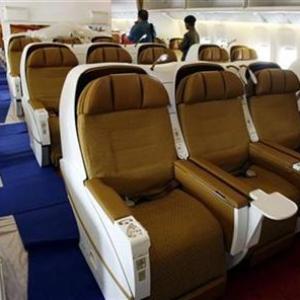 Staff shortage, poor inspection seen as other major pain areas
Staff shortage, poor inspection seen as other major pain areas
The Air India plane involved in an incident at the Delhi airport early last month had been exposed to a higher level of flying risk for five months until May this year, thanks to an engine wear and tear, a recent Directorate General of Civil Aviation audit has revealed.
Among some of the serious concerns that the audit flagged were lack of monitoring, manpower shortage and the carrier’s ageing fleet.
It further exposed the lack of safety oversight the country was grappling with, even as the US Federal Aviation Administration had restored India’s safety ratings early this year.
In its special engineering audit of Air India, conducted in September, DGCA found the airline’s 1994-make Airbus A320 plane had been operating with zero exhaust gas temperature margin from January this year to May, when the engine was finally replaced.
Besides, Air India officials had not conducted proper recording when an inspection of the engine took place in May.
Business Standard reviewed an extract of the report on audit of Air India’s engineering base at Delhi which looked at 'the incident details (of AI) for last one year' to check “maintenance lapse, functional capacity of the organisation” and other parameters.
EGT is used as a measure of an engine’s performance.
The ‘zero EGT margin’ is a condition when an engine’s temperature is at its peak and the engine might require maintenance and engine power restoration.
This condition is mainly seen in older engines, or due to factors like high air temperature outside and high altitude.
Experts say this is not a safety hazard, but the aircraft has to be operated keeping in mind various parameters.
A negative EGT margin could cause an overheating of the engine; if not corrected, this could lead to a fire in extreme cases.
All engines have two fire extinguisher bottles installed.
“Though a negative EGT margin is more dangerous (than zero margin), flying an aircraft with zero margins for five months is a major concern… The engine could have caught fire during high-power take-offs,” said a senior DGCA official.
According to the audit report, the AI aircraft which faced an incident last month was sent for inspection on May 23.
Two days later, one of the engine blades was found to have been damaged; it was only after this that “the engine was finally replaced”. However, the report said “there was no video recording of BSI (Borescope Inspection of engine) on 23 May 2015”.
“This is a serious issue. Since the blade was damaged, the EGT margin could have easily turned negative (in the danger zone).
"Also, a reduced margin requires proper and continuous monitoring which clearly didn’t happen, as there was no video recording of the inspection that took place on 23 May.
"This situation required regular video recording of the engine,” said the DGCA official quoted earlier.
DGCA had initiated the audit after a Khajuraho-Delhi Air India flight had made an emergency landing at the Delhi airport due to a hosepipe failure.
Around 145 passengers had been evacuated after smoke was spotted in the aircraft’s wheel; five passengers were hurt.
The Airbus aircraft involved in this incident was the one that had been flying on zero EGT margin for five months.
In fact, this Airbus A320 aircraft (VT-ESI) had also had an engine fire scare in August last year, following reportedly a loud fire warning alarm on a Kochi-Delhi flight.
An expert said an overheating of the engine was a greater concern, but the aircraft was still flying amid a higher level of financial and operational risk.
“The aircraft was exposed to a higher level of risk.
"Though this can be mitigated, given today’s revenue and financial pressure, it is preferred that airlines take immediate actions to ensure there are no further damage to the aircraft,” said Mark D Martin, founder and chief executive of Martin Consulting, an aviation consulting firm.
Ashwani Lohani, who took charge as Air India’s chairman & managing director on August 31 this year, said: “Ensuring flight safety is our top priority and we are taking all steps required to alleviate any concerns.”
The DGCA audit puts the focus back on Air India’s ageing Airbus A320 fleet. Of the 20 A320s that the airline operates, six have been in service for 26 years and seven for 21 years.
In fact, the airline has sought DGCA’s permission to use three of its A320s for longer than their operational life of 48,000 flight cycles and 60,000 flight hours -- that implies flying these aircraft for more than one-and-a-half years beyond their mandated life.
The Air India management had defended the linking of such incidents to the ageing fleet by saying various international airlines in service were operating 280 A320 aircraft that were older than 20 years.
“Typically older engines have a high tendency to have zero margins, especially where the outside air temperature is more than 40 degrees celcius (a normal thing in India). Though a zero-margin situation is not alarming, it should not be ignored due to safety concerns,” Martin said.
The DGCA probe detected some serious issues related to safety oversight. For instance, an airline is supposed to have a permanent investigation board to probe incidents and determine their cause within six weeks.
“It was found that PIB studies for all incidents were found not carried out on a regular basis due to non-availability of flight safety and flight operations inspectors personnel,” the report said.
“To avoid safety deviations like these from occurring again, it becomes imperative for airlines to set up aircraft health-monitoring systems and put in place procedures, include random audits, checks and actual cockpit observations during flights,” Martin said.
One of the reasons why FAA had downgraded India’s flight safety ratings in February last year (before restoring it in April this year) was a shortage of flight operations inspectors.
Since the downgrade, DGCA had created 75 posts for inspectors and initially hired 55 on contract for three years.
Further, DGCA noticed that there were several instances where the airline had not done a “calculation of man-hour plan”. Every airline is mandated “to review the plan at least every three months and update, when necessary, showing that the organisation has sufficient staff to plan, perform, supervise, inspect and monitor quality” according to the available fleet size.
A DGCA official said some of the airline’s pilots did not maintain a minimum equipment list on flights mentioning the equipment on the aircraft that might be inoperative for the flight.
DGCA AUDIT: KEY FINDINGS
- Air India operated its 1994-make Airbus A320 aircraft for five months since January this year at higher level of risk
- It was found that engine temperature of the aircraft was at its peak during Jan-May this year; a further degradation of engine could have caused fire
- Blade was later found to be damaged; the engine was then replaced in May
- No video recording of inspection was done by the Air India staff
- The same aircraft was involved in an incident at the Delhi airport later in September due to hosepipe failure
- Investigation of all incidents related to Air India flights was not carried out regularly
- Shortage of flight safety inspectors was found
- No minimum equipment list was maintained on several flights telling about equipment on an aircraft that might be inoperative for the flight
Image: Air India fleet. Photograph: Reuters. The image is used for representational purpose only.










